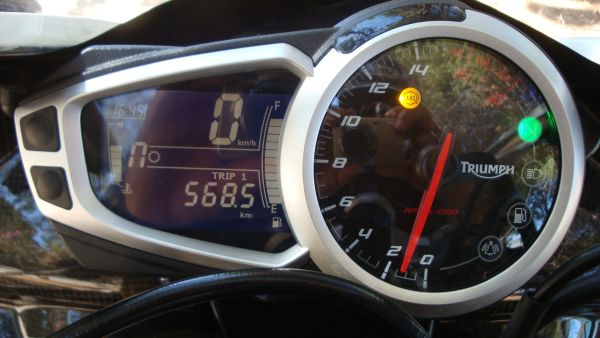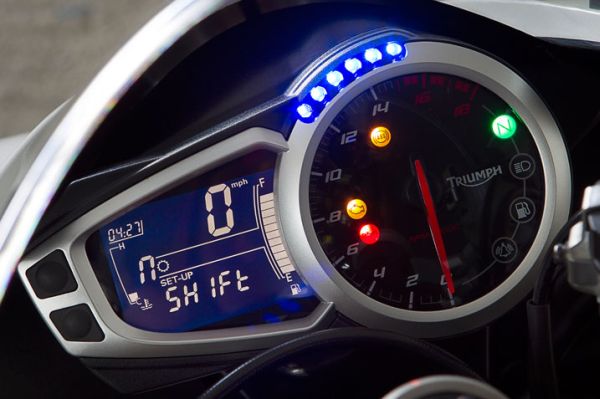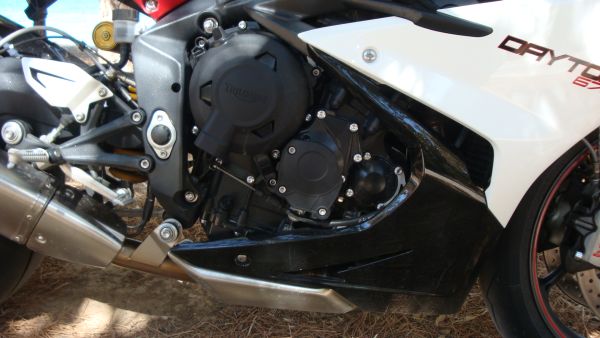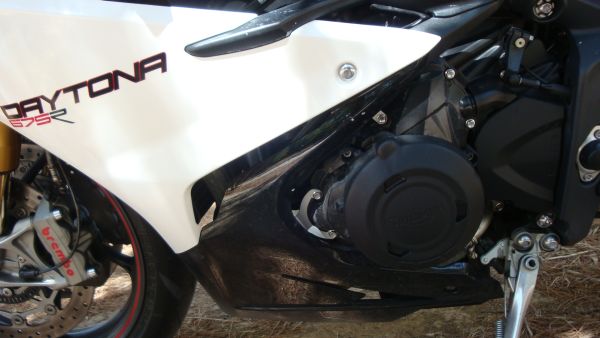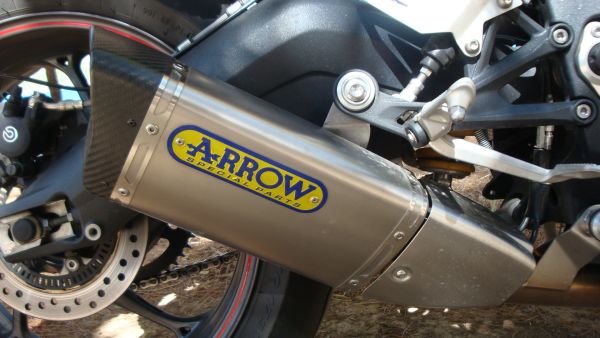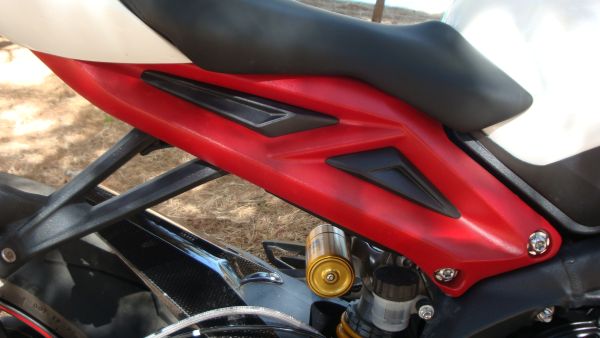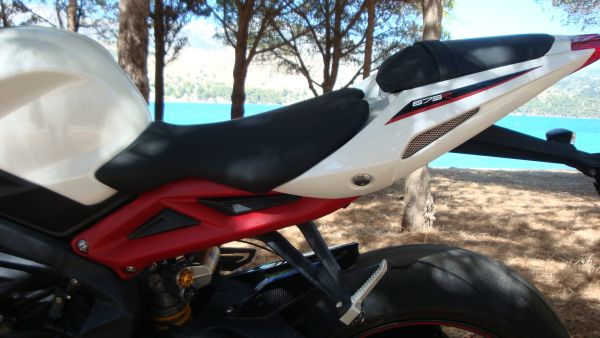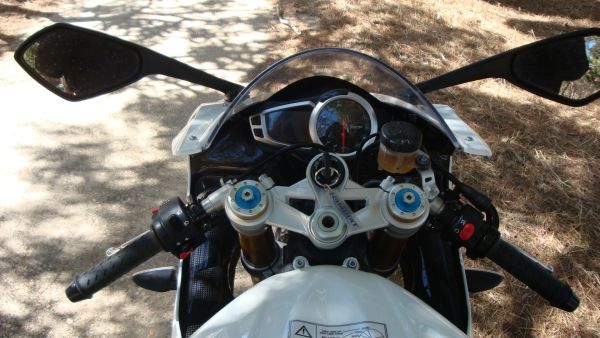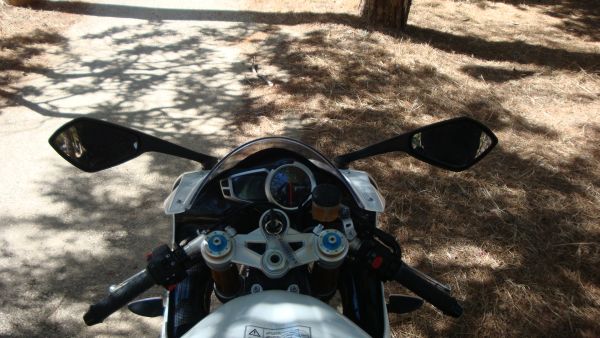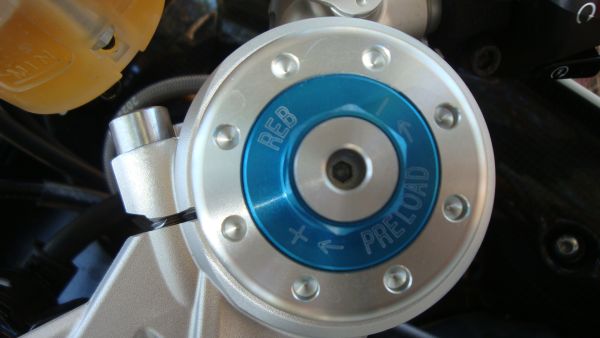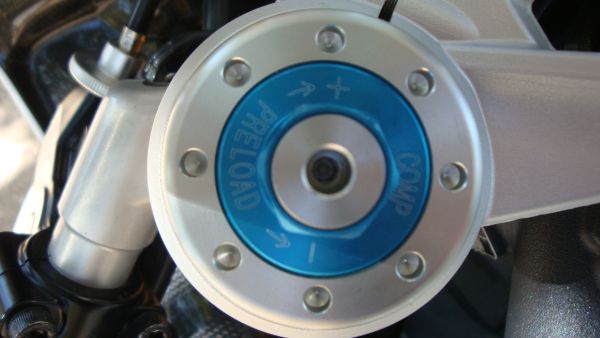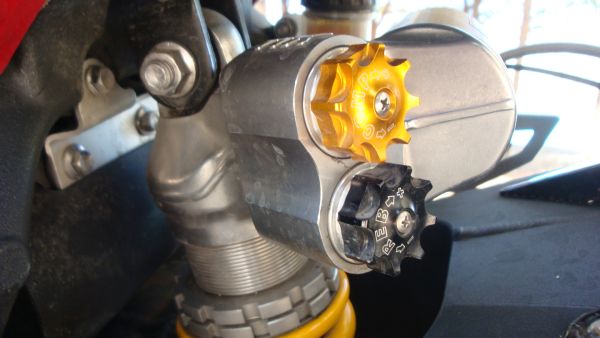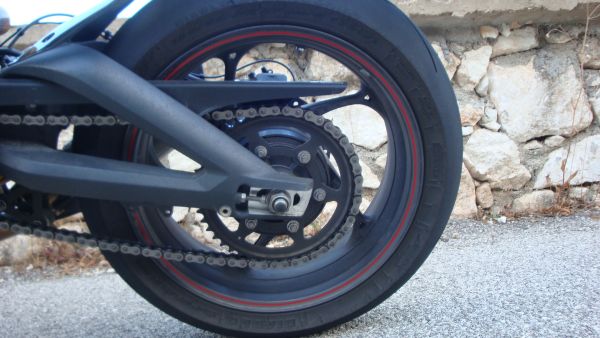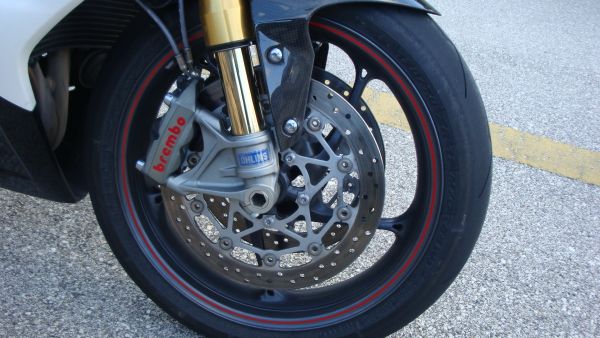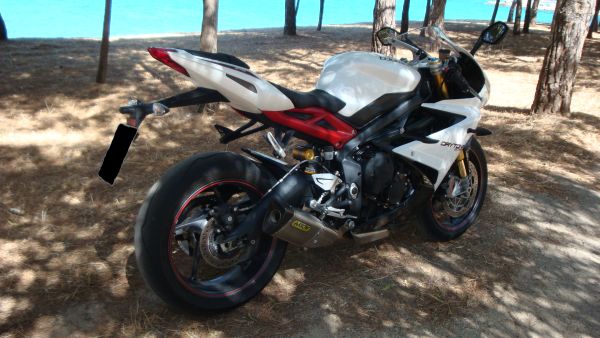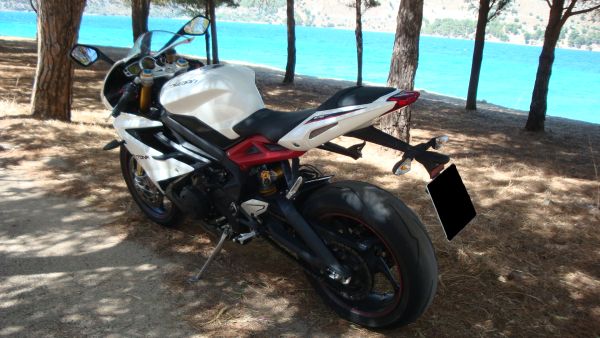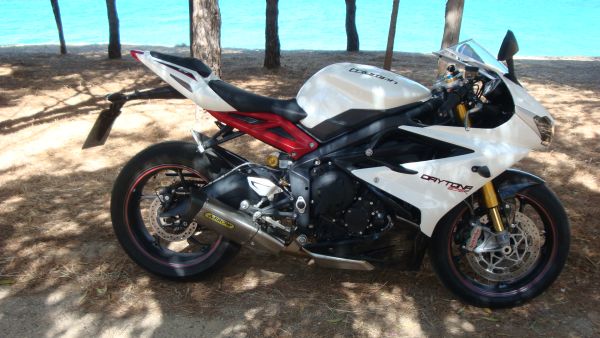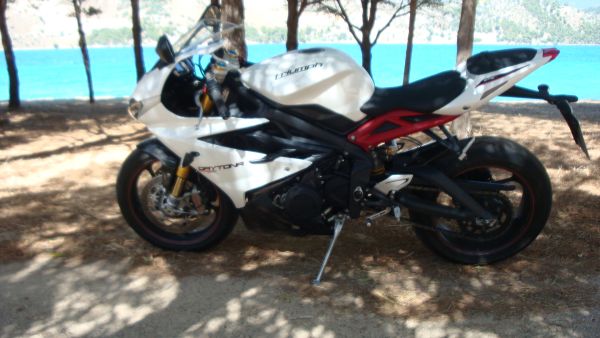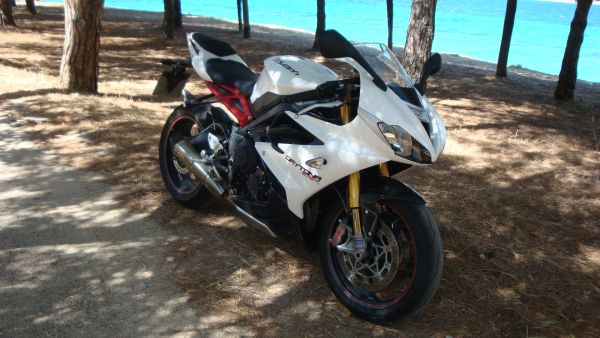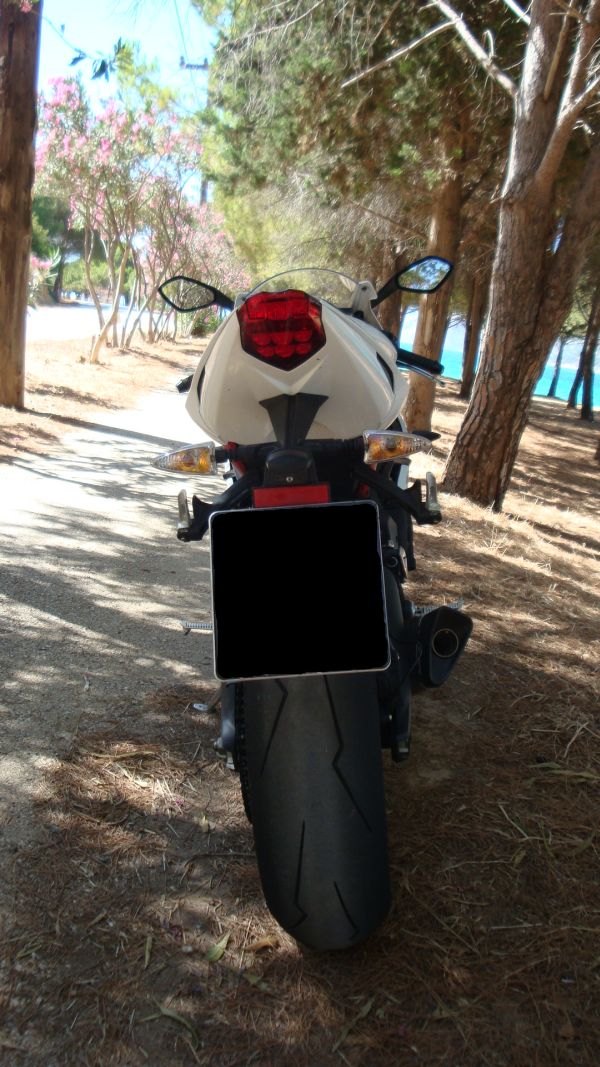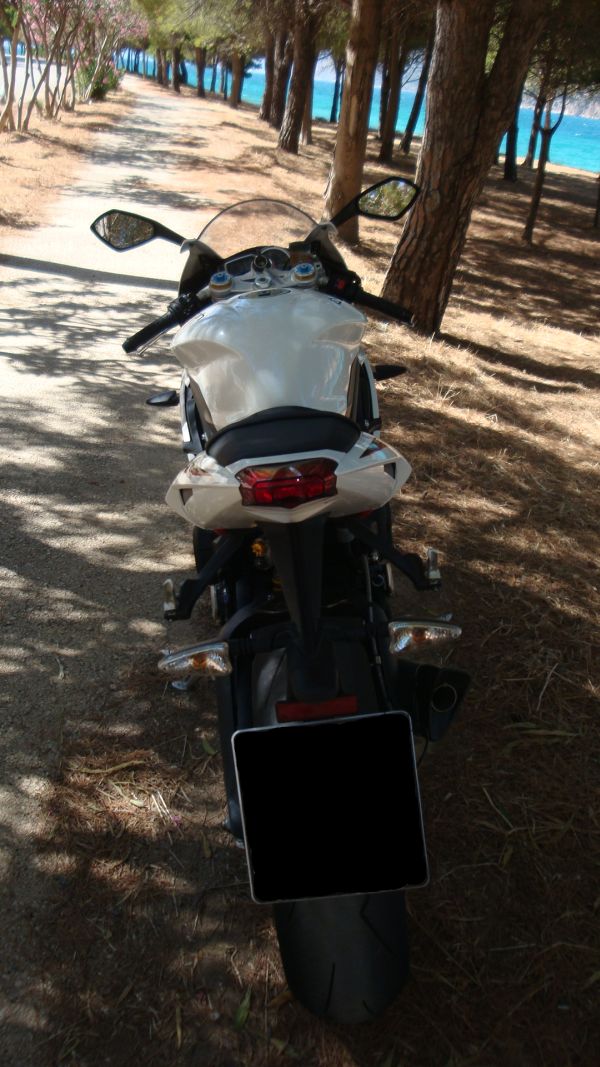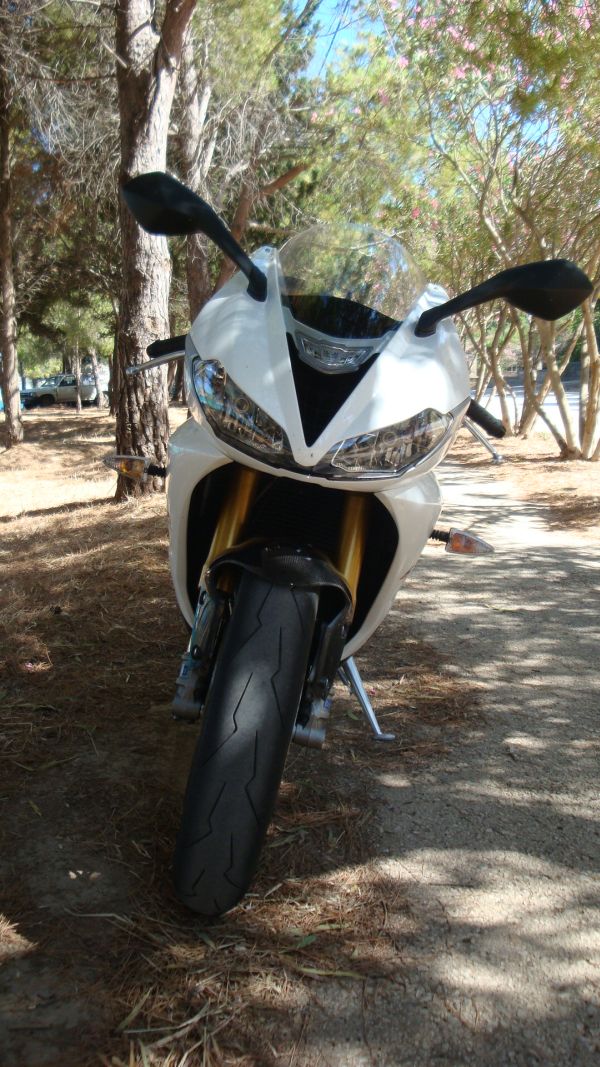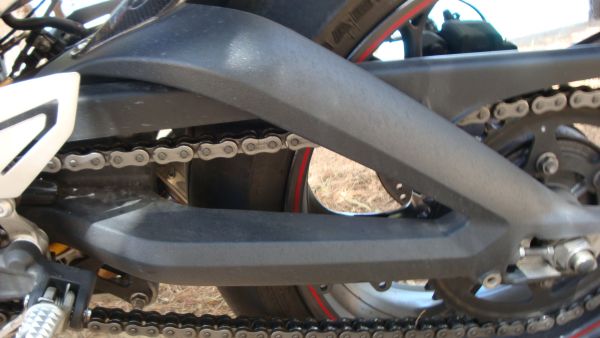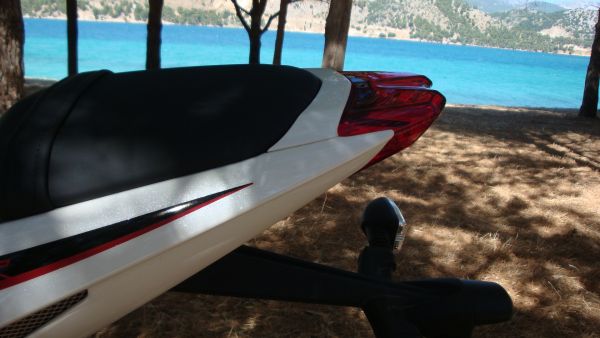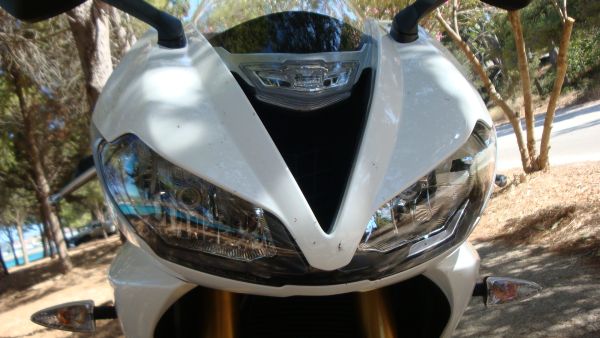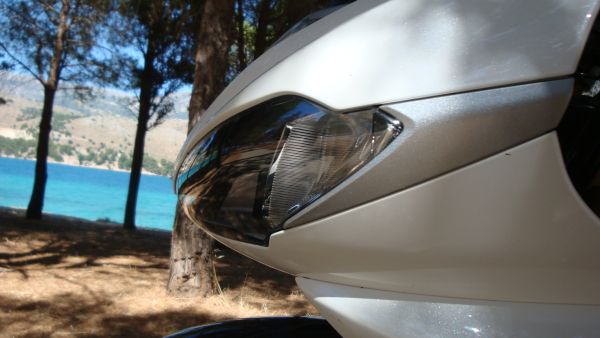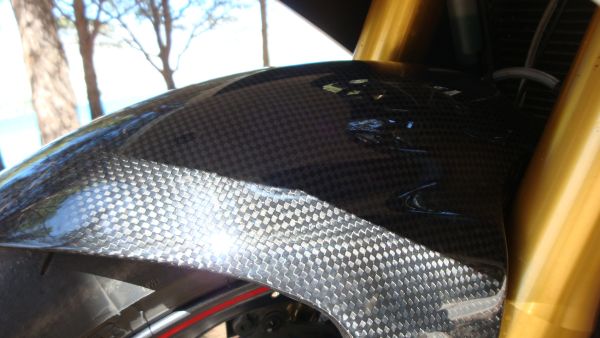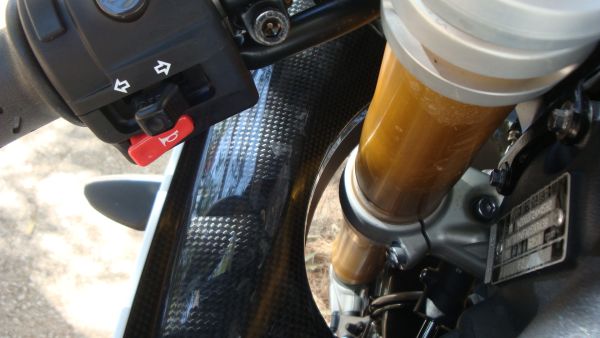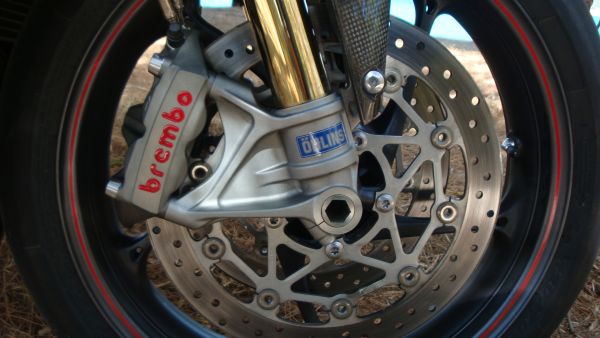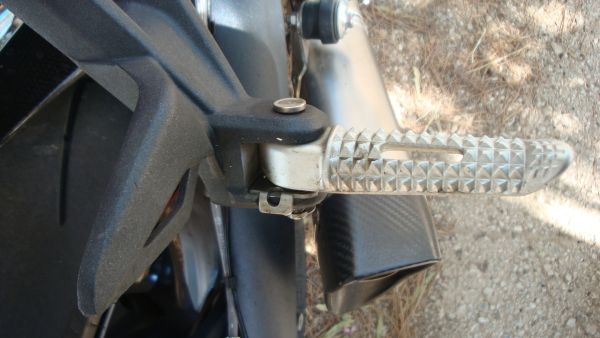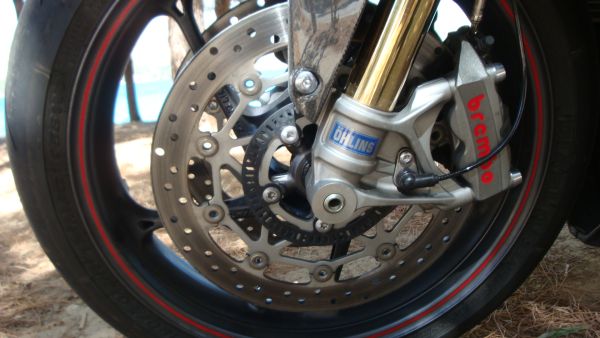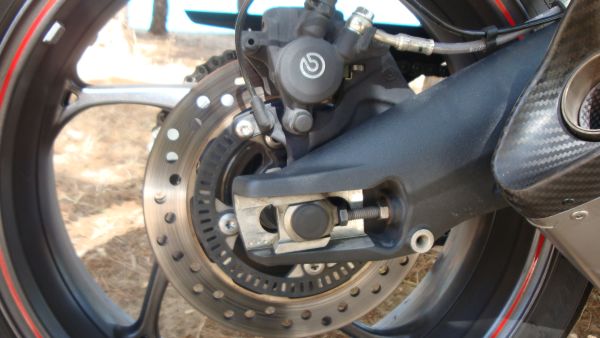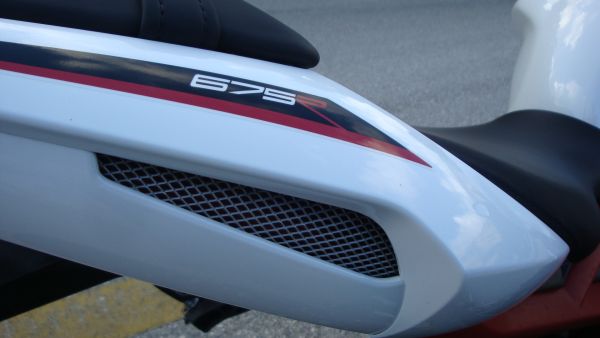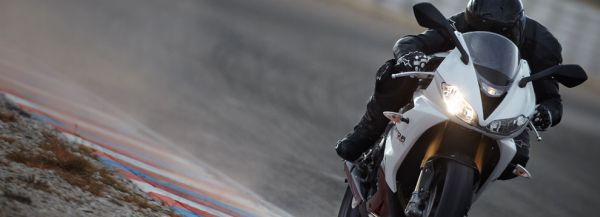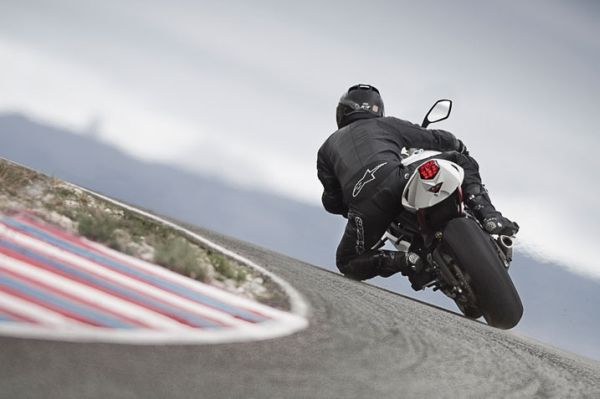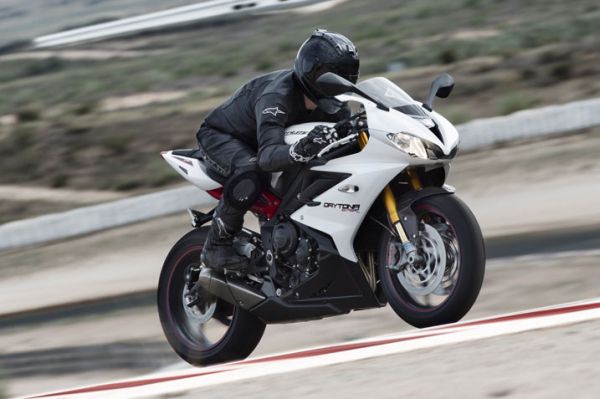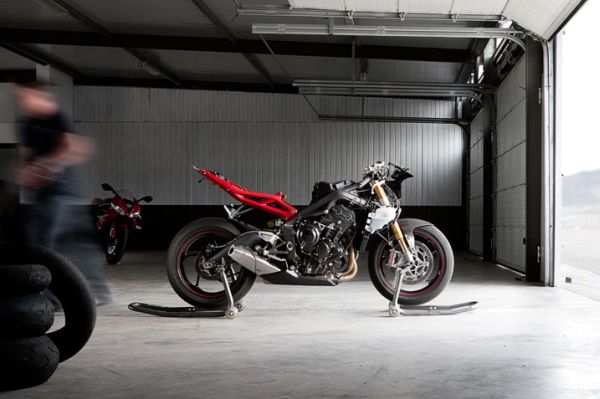Triumph Daytona 675R (2013-current): The sports bike that any fast rider should take into account, no matter the displacement.
‘he bike tested had an Arrow silencer combined with a mapping.Engine: The 675 c.c. three cylinder engine delivers 128 bhp/ 12500 rpm and 7.55 kgm/ 11900 rpm (ft lbs/ 11900 rpm) torque, claimed figures. Actually the sound of the engine is nice as it is heard through the riderĘs helmet. The selected speed indication is very useful.
The engine requires at least 1000 rpm to provide surge-free acceleration. The oomph provided is quite punchy at the 2500 rpm mark, while from 3000 rpm upwards the torque provided resembles to that of a 1000 c.c. superbike. The engine response is very linear. The power provided at the top is really strong, it may be compared only with that of the top class 600 c.c. supersports. The rev limiter intervenes at 14500 rpm indicated figure. The operation of the quickshifter is very good.
The punchy low-middle range of the powerband which is combined in a genuinely linear way with the utterly manageable - yet brilliant power at the top is the strongest advantage of the DaytonaĘs engine compared to the 600 c.c. four cylinder competition. Rider gets the impression that he is riding a 1000 c.c. motorcycle at the low-middle area of the powerband, thus there is no need to change gears constantly. With an engine like this and compared to the 600 c.c. competition, the Daytona 675R is in a class of each own.
On low friction factor roads a traction control would be useful since the power provided is greater than the standards of the category, while the competition requires the use of more and more electronics. Furthermore, a considerable number of potential customers, will be normal riders, not racers! Average fuel consumption for the duration of the test was 6.8 l/100 km (41.54 mpg Imperial), at a fast riding pace.
Riding position: The seat is high 830 mm, (32.7 in.), it will not be suitable to short riders. The bike looks narrow and long from the riding position, thatĘs another similarity with the Ducati 1098, except from the styling.
Rider is placed “on” the bike, the riding position is purely sports which results to a considerable weight transfer to the riderĘs wrists. The 2013 Daytona is slightly more conventional to this aspect than the fully committed previous model, although the combination of the high seat, the weight to the wrists and the hard suspensions results to a bike which is not suitable to everyday use. The low weight 184 kg (405 lbs) wet nominal, is a pleasant surprise.
The pillion is placed a little higher than the rider, which is the only user friendly feature. The saddle for the pillion is narrow, the knees form a steep angle and there is no handlebar. The pillion has to be supported either by the rider – fuel tank or by the tail. The angle of the knees is the most grueling feature.
Thus if there is a girl close to the track asking for a ride towards the race/ track-day, she will not get the time to complain about the Daytona! On longer rides the Triumph becomes uncomfortable for the pillion. Thus the love of a potential couple will be tested for real !!!
On the road: An inverted 43 mm Ohlins NIX is equipped at the front and an Ohlins TTX 36 shock is featured at the rear, the latter with a linkage. Naturally, suspensions are fully adjustable. There is also a steering damper as standard. As it was also mentioned earlier on, the suspensions are quite stiff at their default setting, especially the fork.
OE tyres are Pirelli Supercorsa with dimensions 120/70-17 and 180/55-17. They are a superb choice for dry roads or track which enhances the handling of this superb sporty motorcycle.
In town the Triumph is comparatively stiff, while the riding position is sportier than ideal. However if the traffic is flowing and the streets are of good quality, there will remain only few compromises asked to the rider.
On downtown rides the Daytona starts to feel like a racing bike. Due to the riding position there is a considerable weight on the wrists and the stiff suspensions transmit any road imperfection. The Daytona feels struggling and begging for an open road. The rider will need a scooter or a cub in case of daily downtown rides.
The steering lock is moderate, probably worse than that of the previous model, which featured two alcoves on the fuel tank. During filtering the clip-ons of the Daytona are lower than car mirrors, while the height of the mirrors of the bike is the same with car mirrors. The ABS is a reassuring feature on any case which could go wrong on the road. The clutch is feather-light, which is most helpful on town-downtown rides.
On B-roads the Daytona feels free at last. Rider is not asked for any major compromises, contrary to the previous base model Daytona which was ridden by the editor, feeling absolutely sporty even on ordinary B-roads rides. There is still some weight on the wrists although the rider will get used to it. The second compromise is comfort over road imperfections and derives from the eagerness of the suspensions to transmit any feedback to the rider.
Thus there are no miracles performed here, the Daytona R is not a comfortable motorcycle, just OK on such environment and rides. It would be better if the suspensions were trimmed according to the weight of the editor (70 kg - 154.3 lbs) and this riding pace. However if the owner has comprehended that this is a pure track bike, then these compromises will be forgiven.
The engine is a gem on rides like these, providing instant oomph from the low end. Except from the riding position, the Daytona feels neutral on the road, reminding something between an aggressive supersport 600 and a superbike 1000. Naturally for rides like this a Street Triple becomes a more integrated choice.
At the fast pace the Daytona R is a revelation. On low friction factor roads the sporty riding position creates an aggressive mood. The bike is superbly balanced drifting at the exits in a very natural and highly controlled manner. The engine revs should be kept higher than 8000 rpm for such a pace, at the 10K mark a war has been declared.
On high friction B-roads, the Daytona is utterly neutral despite the aggressive steering geometry (wheelbase 1375 mm, rake 23˚, trail 87.9 mm. - 54.1 in., 23˚, 3.46 in). No matter how vigorously a rider is charging on public B-roads, the Daytona will not reveal any weakness. On the contrary, the Daytona feels quite … insensitive then.
She reminds of the Yamaha R6 at this aspect, this is another motorcycle extremely robust and utterly indifferent to any effort by the rider, mid-turn. Feedback to the rider is superb, the combination of the shock and the tyres keeps the rear planted on the road even on aggressive throttle openings at the exits.
Initially agility could be greater, although itĘs the sublime stability which excels on the road. The light weight of the bike combined with the robustness provided is a great help on such a pace, feeling like a pure racing bike.
The brakes are also most helpful to the rider on such a pace, at the Circuit mode. A nimble rider could also be confident selecting the plain ON mode, which almost prohibits stoppies. At the Circuit mode the rider may drift the rear wheel at the entrance.
The engine is superb. Rider forgets any performance numbers, the power provided is all that a rider will ever need on a public B-road, which feels something between a four cylinder 600 and 1000 c.c. bike. The Daytona is a beast!
Compared to the four cylinder 600 c.c. competition there is some time gained between two bends since the Daytona is catapulted to the front due to the power provided and with the aid of the quickshifter, even in case of selecting a higher speed on the gearbox. The result of the above remarks is that the Daytona may be ridden as a 600 c.c. bike maintaining a high entry and cornering speed (while rider may make a correction if this is required), or as a 1000 c.c. superbike especially on slow bends, where rider could keep the brakes deep into the turn, make the maneuver after that, fully opening the throtle at the exit.
Power wheelies are easier than the four-cylinder 600 c.c. competition which certifies that the oomph provided cannot always be described by plain numbers. An 1000 c.c. superbike will overtake the Daytona relatively easy on the straight, on a tight course it will probably be the opposite. Since only a few riders will buy the Daytona solely for track use, a traction control which could be deactivated would be welcomed for ordinary rides. The slipper clutch was superb on this road test, although its not absolutely necessary on such an environment, since riding on the next available speed at the gearbox, is always an option.
On the highway the Daytona could be comfortable even at a speed of 180 km/h (112 mph). Air protection is relatively good, certainly better than expected. The air resistance relieves somewhat the wrists of the rider from the weight applied. Maybe itĘs the long shape of the bike which enhances the fairing to be placed further at the front, providing better air protection despite the small dimensions. Thus there is some air flow around the rider and on the helmet (a high quality one is required for travelling).
The stability is exceptional despite the short wheelbase. Thus the rider could think that the traveling speed is slower than the one indicated on the instrument.
If it will be necessary to ride on a dirt road, the Daytona R is adequate if there are no stones, otherwise she becomes hard and inconvenient. The high and wide handlebar of the Street Triple would provide better control on roads like this.
‘he ABS brakes consist of twin 310 mm rotors at the front featuring four piston calipers and a single pot caliper at the rear. The calipers are Brembo, steel brake lines are featured, while there are three operating modes for the ABS: Off, On and Circuit.
Selecting the On mode for the ABS the bike will hardly do any stoppies. The brakes provide good power, good initial bite and relatively good feedback to the rider. This is a choice suitable for any road use.
Selecting the Circuit mode for the ABS, the Daytona is transformed to a stoppie machine. The brakes provide good feedback, very good initial bite and power, front and rear. Conclusively these brakes are an equivalent part of an exceptional sport bike, road or track, providing the best possible result.
Model history/reliability/build quality: ‘he Daytona was introduced in 2006 and it became soon the favourite choice of many track day focused riders. In 2009 there were some minor modifications while in 2011 the R version was presented, featuring Brembo brakes, Ohlins suspensions and some carbon fiber parts. In 2013 there were extensive and significant changes concerning the aluminum frame and swingarm, the suspensions, engine etc., while the silencer is now low slung at the right instead of high at the tail.
Compared to the base model, the R is differentiated due to the upgraded fork, the red subrame, the red stripes on the wheels and some carbon fiber parts. The base model gets a lower saddle, a Kayaba fork, Nissin brakes, the steering geometry is more conservative, while the quickshifter and the ABS are optional.
There is a recall these days (end of July 2013) concerning the ABS modulator on Daytona and Street Triple, base models or R versions. The build quality is superb, equivalent to that of the Japanese bikes.
Comments: ‘he instruments look quite plastic given the character and the price of the motorcycle, since they look like a cheap steel imitation. They are featured on many Triumph models looking rather dated now. The total mileage indication can be seen only when the electric system of the bike is turned on, not during the ride. A lap timer, a quickshifter and a programmable shift light are standard equipment.
‘he styling resembles to that of Ducati 1098, which was quite honorable for the Italian bike, as long she was being manufactured. According to the editorĘs opinion this styling looks quite familiar now, in 2013. Certainly this is rather subjective, however a styling change is required, since the appearance of the bike does not coincide anymore with her explosive character and the numerous exciting moments that the owner will actually get. The tail light is very small, as minimal as it can ever be. The base for the number plate is meant to be removed for track use.
The frame is a combination of a twin spar √ – shaped and a Trellis one. By over-simplifying the basic shape from the side, it looks like the initial Suzuki GSXR 750! There are no further similarities between this and the handling of the 1986 Suzukis, which is an indication of the superb British frame engineering.
Conclusively the Daytona R is a step beyond the 600 c.c. four-cylinder competition (the bikes ridden from this website actually) and especially in case of sporty rides. As a matter of fact, completing the test the editor was back on his personal 2007-8 Honda CBR600RR, which seemed a sluggish, relatively heavy and very underpowered at the low end – midrange motorcycle!
Price Daytona R: 14290§
+ An explosive character given the engine displacement
+This performance is placed between 600 and 1000 c.c. four-cylinder competition
+ Riding excitement for demanding riders
+ Performance-handling-brakes
- Needs a change in styling and instruments
- Ease of everyday use-high pillion pegs
- Traction control
- Price



